There I was, surrounded by egrets, spoonbills, herons, cormorants, and other birds; where else would you want to be with your camera on a sunny afternoon with the sun at your back and unending avian action criss-crossing in flight before you. I thoroughly enjoyed almost 2 hours of photographing the birds in their beautiful alternate plumage that showed prime colors and plumes as they began their nesting season. My main interest was to photograph Roseate Spoonbills in flight, and this was the place to do that, and the timing and lighting was perfecto.
There was constantly a bird or several birds flying by, usually from side to side, passing by in front of me. Great Egrets and Roseate Spoonbills provided most of the action, along with Snowy Egrets and Double-crested Cormorants, and eventually Tricolored Herons flew into the area in flocks of 4 or 5 at a time. What fun, and what a great photo opportunity!
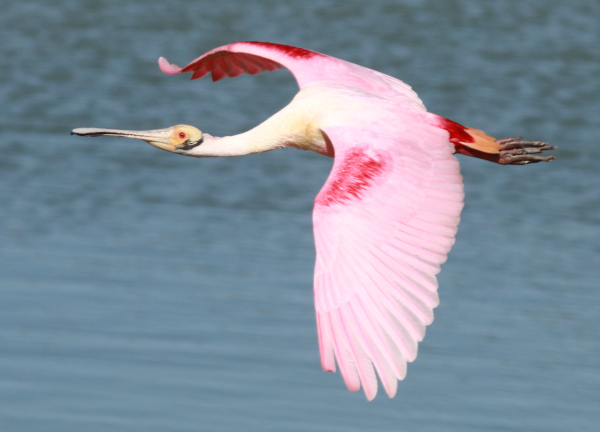
The elevated walkway provided a little different perspective on the Roseate Spoonbills flying by and helped to avoid shadows formed beneath the birds.
My secret photo location was at the edge of a nesting colony for wading birds – a rookery, located a couple miles inland from the east end of the Bolivar Peninsula on the southeast Gulf Coast of Texas. My perch was on the east deck of the elevated Canopy Walkway at Smith Oaks Bird Sanctuary at the rookery on the edge of the little village of High Island. This is one of the best birding locations in the United States due to the nesting wading birds, but it’s even better known as a songbird staging area during spring – a place where thousands of warblers and other songbirds stop after crossing the expansive Gulf waters from the Yucatan Peninsula in Mexico. Then too, the adjacent coastline of the Bolivar Peninsula is a prime location for shorebirds, terns, and other birds to pause during their northbound migration.
Roseate Spoonbills were still in the earliest stage of their nesting cycle, with their behavior emphasizing pairing, and establishing a territory around a potential nest site. Those activities apparently required a lot of flying back and forth to and from the rookery trees, thereby providing me with countless opportunities to follow the flights of the big pink birds within my photo frame, working out my 400mm telephoto lens and its autofocus, along with the camera’s light meter.
Elevation Eliminated Shadows
Standing on the high deck overlooking the action to the south of the principal rookery island gave me the somewhat unusual position of photographing birds from a point slightly above them as they flew to and from the rookery. Rarely did the birds fly higher than the deck, so I was photographing them at a slightly downward angle, which I found was very helpful. Because I arrived while the sun was still at a little higher angle than optimum, from a ground level position I would have been photographing from beneath the flying birds, or from the side at best, when shadows would make photographing the birds much trickier. But from the elevated deck, most or all shadows were eliminated from my camera view, the sun illuminated their back and side beautifully, providing unshaded photos of the birds.
As the sun’s position was lower in the sky, I tried positioning at the shore of the lake, which worked well when the angle of the sun provided ample light from the side without shadows. But I must admit that I preferred the elevated walkway and deck to photograph from because it provided a more open view to see birds approaching from a distance, and I liked the rather unique photo angle slightly above the birds.
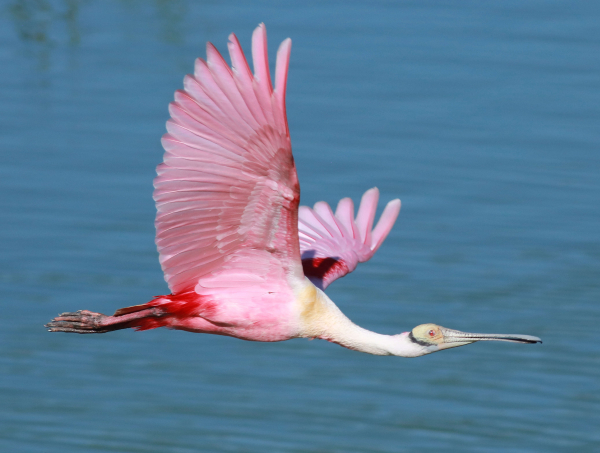
The dramatic pink colors of spoonbills are offset by their unusual head and bill. This photo session provided the first good photos of Roseate Spoonbills in flight for Paul, which was his hope for this outing.
Setting up at a location where birds are passing by from a nesting site, roosting location, or a feeding area is usually a very effective place to take flight photographs. I was also very aware of the background options, and preferred the water below and beyond the birds as a mostly uniform background that would contrast with the birds colors while providing a pleasing natural backdrop.
I used my usual standard camera settings: ISO 400, with an aperture of f8. As you may remember, I always use the Av setting on the Mode Dial, which provides an aperture-priority shutter speed automatically. In this case, with ample sunlight the shutter speeds varied from 1/1000 to 1/1600 – very fast – that would stop all or most action when the birds were flying or interacting. However, the photo that shows the interaction between the Great Egrets had a shutter speed of 1/3200, which is surprising, but it definitely stopped the action.
As always, I kept my camera set for a continuous series of photos, which allows me to take a series of images at a rate of 3 to 5 photos per second when I hold the shutter button down (some camera models take up to 20 frames per second). However, during this photo session I found that I almost always took single photos, often 2 at a time (click, click), as birds passed by.
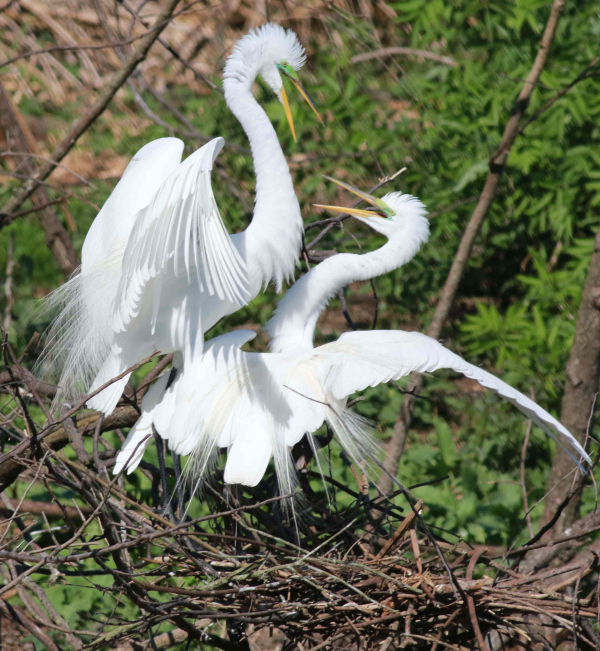
Among the constant activity at the rookery nest sites an interaction between this pair of Great Egrets provided a quick opportunity to take a few action photos as they interacted rather aggressively during the male’s return. This photo was taken at a surprising shutter speed of 1/3200 of a second.
Rookery Action
There was also the action at the rookery to provide another segment of photo ops. Great Egrets regularly brought a new stick to their mates standing on their flimsy stick nests. A few egrets were already incubating a turquoise-colored clutch of eggs too. Pairs of egrets periodically displayed to one another, and to those around them, as pair bonding and territorial acts. Several cormorants were also already incubating, and many were still collecting sticks, but they seemed to prefer live sticks with leaves. It was great fun to see the interactions between birds, and to document individuals and pairs in action from the top of the canopy walkway, all surrounded by an unusual mix of calls.
While it was especially interesting to observe the activities within the crowded rookery, it was hard to get a clear photo of active nest sites that tended to be built where they were surrounded by the young twigs on tree branches. Eventually, these “sticks” will leaf out and further conceal the nests, and perhaps shade them as well, so nesting photos were more limited even though there were many nests built and many more to be initiated as the season progresses. Another concern about rookery photos was the background among the small trees, which for me was very chaotic, but natural nonetheless.
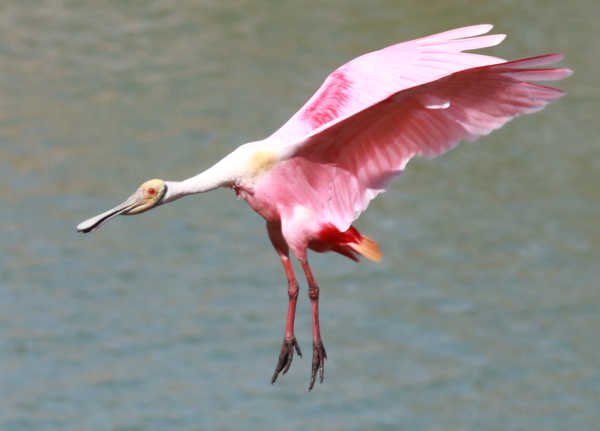
As this spoonbill lands, it shows the full length of its wings, neck, bill, and legs.
There were a few other photographers in the area, all with different equipment, all enjoying the avian activities as much as me it seemed. About 5:20pm, as I was leaving, more photographers were arriving. Perhaps they were stopping by after work, or perhaps they anticipated a flight of birds returning to the rookery at the end of the day. I was happy with my photos, and thrilled with the opportunity and experiences – it was a day to remember!
In retrospect, I was super-lucky with my timing and the layout of the rookery and photo areas. If I had arrived early in the morning, the direction of the sunlight would have been terrible. Without knowing the all-important layout of the rookery and walkway with regard to the sun, this could have been merely a preliminary visit that would require me to return during the prime lighting period on another sunny day to photograph. As it turned out, I couldn’t have planned things better.
In addition to the nesting activities of the wading birds, in just a couple weeks the trees along the canopy walkway will periodically be filled with the action of small songbirds and flycatchers – neotropic songbirds that winter in Latin America and nest in Canada and the United States. These will include a variety of different species of warblers, vireos, buntings, orioles, tanagers, and flycatchers. I could just imagine the action of the birds, and the birders attracted to them along the elevated walkway where you are positioned along the top third of the treetops. I definitely would enjoy being a part of that action – surrounded by birds and birders – and I’m hoping to do just that on my return from photographing in Florida.
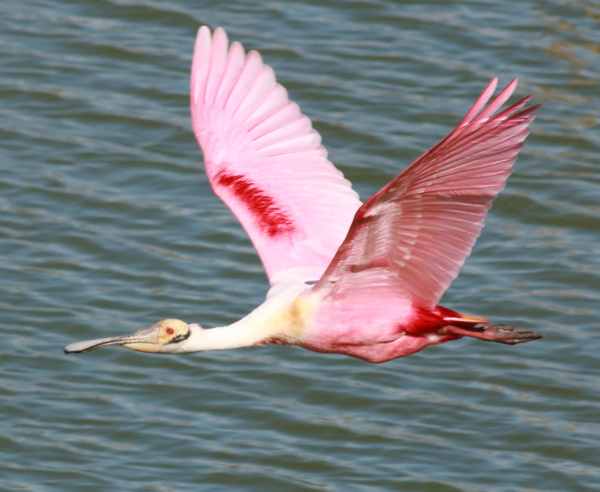
One observer who was not photographing described the activity before us as tranquil, and it was, aside from the excitement of photographing the birds and the mix of activity at the rookery.
To learn more about Houston Audubon’s High Island Bird Sanctuaries and Canopy Walkway and to view a short video of the area, see https://houstonaudubon.org/sanctuaries/high-island/visitor.html and if you have a chance, plan to visit. Enjoy your week!
Article and photographs by Paul Konrad
Share your bird photos and birding experiences at editorstbw2@gmail.com